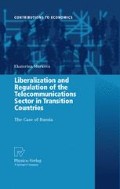Regulation is very often associated with the post-privatization control of utilities. However, regulation has been practiced in many countries for many decades, e.g. in Britain since the Tudor and Stuart period at least.
Based on Baldwin and Cave (1999, p. 223), three phases involved in the transition process from monopoly to fully competitive markets can be primarily differentiated (see Fig. 4.1). In phase one, pre-competitive markets, competition is emerging, and regulation can be used to prevent any firm monopolizing a distribution network, giving an advantage to an affiliated supplier over any others or disclosing the access for market newcomers. Price regulation of suppliers (endcustomer prices) as well as of monopoly distribution elements (access prices) are used to protect end-consumers as well as newcomers; and sector-specific measures, covering such matters as service standards, are again necessary to protect consumers. In phase two, emerging competitive markets, price regulation can be withdrawn from fully competitive parts of the market (but retained for monopoly network provision) and firms allowed to compete. As competition increases, there may be a regulatory retreat from detailed prescriptive controls over such matters as service standards and growing reliance on market pressure to protect consumers. In phase three, fully competitive markets, economic regulation becomes largely unnecessary and general competition laws can be used to secure the operation of the market. The need to regulate becomes confined to the use of special rules to ensure such matters as the compatibility of networks and the ability of consumers to purchase from a range of suppliers. Limited social objectives (such as universal service) can be achieved through special arrangements which are designed to avoid distorting competition.
Access this chapter
Tax calculation will be finalised at checkout
Purchases are for personal use only
Preview
Unable to display preview. Download preview PDF.
Rights and permissions
Copyright information
© 2009 Physica-Verlag Heidelberg
About this chapter
Cite this chapter
(2009). Theory of Network Regulation and Regulatory Policy Options in the Telecommunications Sector. In: Liberalization and Regulation of the Telecommunications Sector in Transition Countries. Contributions to Economics. Physica-Verlag HD. https://doi.org/10.1007/978-3-7908-2104-8_4
Download citation
DOI: https://doi.org/10.1007/978-3-7908-2104-8_4
Publisher Name: Physica-Verlag HD
Print ISBN: 978-3-7908-2103-1
Online ISBN: 978-3-7908-2104-8
eBook Packages: Business and EconomicsEconomics and Finance (R0)

